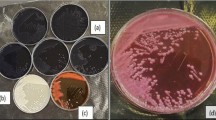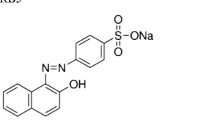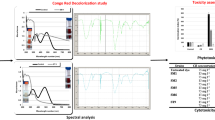Abstract
The existence of synthetic dyes and heavy metals in textile wastewater is a serious problem. These compounds should be removed before discharge into the environment by an appropriate method. The present study was conducted for the characterization of efficient multi-functional strain Bacillus cereus MS038EH for the simultaneous removal of Reactive Black-5 and Chromium(VI). Maximum decolorization efficiency of 94.74% was achieved at pH 7, 35 °C, and 4% inoculum size for 900 mg/L of Reactive Black-5. Also, 94.10% efficiency was observed in the presence of 8 g/L of yeast extract as an optimum nitrogen source, while carbon sources had no significant effect on decolorization. It should be pointed out that the decolorization efficiency was decreased from 94 to 64% by increasing NaCl concentrations from 0 to 50 g/L, respectively. Bacillus cereus strain MS038EH could decolorize 94.31% of Reactive Black-5 (900 mg/L) and remove 87.31% of chromium(VI) (30 mg/L) within 36 h. Results of Gas chromatography–mass spectrometry and Fourier transform-infrared spectroscopy proved that Reactive Black-5 was cleaved into the lower molecular weight products without any azo bonds. However, the phyto-toxicity analysis showed that Reactive Black-5 was not toxic for Triticum aestivum and Maize, while biologically treated Reactive Black-5 was toxic for seeds. Therefore, ultraviolet-C/H2O2 was applied for the detoxification of biotransformed products. When ultraviolet-C/H2O2 was applied as post-treatment, the seeds were germinated completely. It is demonstrated that the application of ultraviolet-C/H2O2 after anaerobic treatment is effective for toxicity reduction of textile wastewater.







Similar content being viewed by others
References:
Akansha K, Chakraborty D, Sachan SG (2019) Decolorization and degradation of methyl orange by Bacillus stratosphericus SCA1007. Biocatal Agric Biotechnol 18:101044
Aksu Z, Dönmez G (2003) A comparative study on the biosorption characteristics of some yeasts for Remazol Blue reactive dye. Chemosphere 50:1075–1083
Alaimolaei M, Golchin M (2016) An Efficient DNA Extraction Method for Lactobacillus casei, a Difficult-to-Lyse Bacterium. Int J Enteric Pathog 4:1–6
Aleboyeh A, Olya ME, Aleboyeh H (2008) Electrical energy determination for an azo dye decolorization and mineralization by UV/H2O2 advanced oxidation process. Chem Eng J 137:518–524
Al-Ghouti MA, Khraisheh MAM, Allen SJ, Ahmad MN (2003) The removal of dyes from textile wastewater: a study of the physical characteristics and adsorption mechanisms of diatomaceous earth. J Environ Manage 69:229–238
Almeida EJR, Corso CR (2014) Comparative study of toxicity of azo dye Procion Red MX-5B following biosorption and biodegradation treatments with the fungi Aspergillus niger and Aspergillus terreus. Chemosphere 112:317–322
Anwar F, Hussain S, Ramzan S, Hafeez F, Arshad M, Imran M, Maqbool Z, Abbas N (2014) Characterization of reactive red-120 decolorizing bacterial strain Acinetobacter junii FA10 capable of simultaneous removal of azo dyes and hexavalent chromium. Water Air Soil Pollut 225:2017
Asad S, Amoozegar MA, Pourbabaee A et al (2007) Decolorization of textile azo dyes by newly isolated halophilic and halotolerant bacteria. Bioresour Technol 98:2082–2088
Ayed L, Mahdhi A, Cheref A, Bakhrouf A (2011) Decolorization and degradation of azo dye Methyl Red by an isolated Sphingomonas paucimobilis: biotoxicity and metabolites characterization. Desalination 274:272–277
Banerjee S, Kamila B, Barman S et al (2019) Interlining Cr (VI) remediation mechanism by a novel bacterium Pseudomonas brenneri isolated from coalmine wastewater. J Environ Manage 233:271–282
Bose RB, Thillaichidambaram M, Paulraj B et al (2018) Bio-decolourization of Reactive Blue EFAF using halotolerant Exiguobacterium profundumstrain CMR2 isolated from salt pan. Biocatal Agric Biotechnol 16:98–106
Brindha R, Muthuselvam P, Senthilkumar S, Rajaguru P (2018) Fe0 catalyzed photo-Fenton process to detoxify the biodegraded products of azo dye Mordant Yellow 10. Chemosphere 201:77–95
Chaleshtori AAN, Meghadddam FM, Sadeghi MM et al (2017) Removal of Acid Red 18 (Azo-Dye) from aqueous solution by adsorption onto activated charcoal prepared from almond shell. J Environ Sci Manag 20:9–16
Chang M-C, Shu H-Y, Yu H-H (2006) An integrated technique using zero-valent iron and UV/H2O2 sequential process for complete decolorization and mineralization of CI Acid Black 24 wastewater. J Hazard Mater 138:574–581
Chen G, Hong Huang M, Chen L, Hui Chen D (2011) A batch decolorization and kinetic study of Reactive Black 5 by a bacterial strain Enterobacter sp. GY-1. Int Biodet Biodegrad 65:790–796
Cheng T-S (2012) The toxic effects of diethyl phthalate on the activity of glutamine synthetase in greater duckweed (Spirodela polyrhiza L.). Aquat Toxicol 124:171–178
Cheng L-J, Cheng T-S (2012) Oxidative effects and metabolic changes following exposure of greater duckweed (Spirodela polyrhiza) to diethyl phthalate. Aquat Toxicol 109:166–175
Cheng H, Yuan M, Zeng Q et al (2021) Efficient reduction of reactive black 5 and Cr (VI) by a newly isolated bacterium of Ochrobactrum anthropi. J Hazard Mater 406:124641
Coates J (2006) Interpretation of infrared spectra, a practical approach. Encycl Anal Chem Appl theory Instrum:10815–10837. https://doi.org/10.1002/9780470027318.a5606
Comeau Y, Greer CW, Samson R (1993) Role of inoculum preparation and density on the bioremediation of 2, 4-D-contaminated soil by bioaugmentation. Appl Microbiol Biotechnol 38:681–687
Dafale N, Rao NN, Meshram SU, Wate SR (2008) Decolorization of azo dyes and simulated dye bath wastewater using acclimatized microbial consortium–biostimulation and halo tolerance. Bioresour Technol 99:2552–2558
Deng D, Guo J, Zeng G, Sun G (2008) Decolorization of anthraquinone, triphenylmethane and azo dyes by a new isolated Bacillus cereus strain DC11. Int Biodet Biodegrad 62:263–269
Dilhari A, Sampath A, Gunasekara C et al (2017) Evaluation of the impact of six different DNA extraction methods for the representation of the microbial community associated with human chronic wound infections using a gel-based DNA profiling method. AMB Express 7:179–190
El Bouraie M, El Din WS (2016) Biodegradation of Reactive Black 5 by Aeromonas hydrophila strain isolated from dye-contaminated textile wastewater. Sustain Environ Res 26:209–216
El-Rahim WMA, Moawad H, Azeiz AZA, Sadowsky MJ (2017) Optimization of conditions for decolorization of azo-based textile dyes by multiple fungal species. J Biotechnol 260:11–17
Emadi Z, Sadeghi M, Mohammadi-moghadam F et al (2020) Decolorization of Reactive Black-5 High Concentration by Vermicompost Microflora and Detoxification of By-Products by UV-C/H2O2 Post-Treatment. Pollution 6:503–511
Emadi Z, Sadeghi M, Forouzandeh S, et al (2021) Simultaneous decolorization/degradation of AB-113 and chromium (VI) removal by a salt-tolerant Klebsiella sp. AB-PR and detoxification of biotransformed-metabolites. Int J Environ Sci Technol. https://doi.org/10.1007/s13762-021-03360-9
Farzianpour F, Khaniki GJ, Younesian M et al (2013) Evaluation of food color consumption and determining color type by thin layer chromatography. Am J Appl Sci 10:172
Fazeliyan E, Sadeghi M, Forouzandeh S, et al (2021) Decolorization mechanism, identification of an FMN‐dependent NADH‐azoreductase from a moderately halotolerant Staphylococcus sp. MEH038S, and toxicity assessment of biotransformed metabolites. Water Environ Res. https://doi.org/10.1002/wer.1580
Gómez-Tenorio MA, Zanón MJ, de Cara M et al (2015) Efficacy of dimethyl disulfide (DMDS) against Meloidogyne sp. and three formae speciales of Fusarium oxysporum under controlled conditions. Crop Prot 78:263–269
Hashem RA, Samir R, Essam TM et al (2018) Optimization and enhancement of textile reactive Remazol black B decolorization and detoxification by environmentally isolated pH tolerant Pseudomonas aeruginosa KY284155. AMB Express 8:83–95
He H, Chen Y, Li X et al (2017) Influence of salinity on microorganisms in activated sludge processes: a review. Int Biodet Biodegrad 119:520–527
Hu T-L (2001) Kinetics of azoreductase and assessment of toxicity of metabolic products from azo dyes by Pseudomonas luteola. Water Sci Technol 43:261–269
Huang G, Wang W, Liu G (2015) Simultaneous chromate reduction and azo dye decolourization by Lactobacillus paracase CL1107 isolated from deep sea sediment. J Environ Manage 157:297–302
Imran M, Crowley DE, Khalid A et al (2015) Microbial biotechnology for decolorization of textile wastewaters. Rev Environ Sci Bio/technol 14:73–92
Imran M, Arshad M, Negm F et al (2016) Yeast extract promotes decolorization of azo dyes by stimulating azoreductase activity in Shewanella sp. strain IFN4. Ecotoxicol Environ Saf 124:42–49
Jonstrup M, Punzi M, Mattiasson B (2011) Comparison of anaerobic pre-treatment and aerobic post-treatment coupled to photo-Fenton oxidation for degradation of azo dyes. J Photochem Photobiol A Chem 224:55–61
Khan R, Bhawana P, Fulekar MH (2013) Microbial decolorization and degradation of synthetic dyes: a review. Rev Environ Sci Bio/technol 12:75–97
Khan Z, Jain K, Soni A, Madamwar D (2014) Microaerophilic degradation of sulphonated azo dye–Reactive Red 195 by bacterial consortium AR1 through co-metabolism. Int Biodeterior Biodegrad 94:167–175
Koparal AS, Yavuz Y, Gürel C, Öğütveren ÜB (2007) Electrochemical degradation and toxicity reduction of CI Basic Red 29 solution and textile wastewater by using diamond anode. J Hazard Mater 145:100–108
Kumar N, Sinha S, Mehrotra T et al (2019) Biodecolorization of azo dye Acid Black 24 by Bacillus pseudomycoides: process optimization using box behnken design model and toxicity assessment. Bioresour Technol Rep 8:100311
Kurade MB, Waghmode TR, Khandare RV et al (2016) Biodegradation and detoxification of textile dye Disperse Red 54 by Brevibacillus laterosporus and determination of its metabolic fate. J Biosci Bioeng 121:442–449
Lafi R, Gzara L, Lajimi RH, Hafiane A (2018) Treatment of textile wastewater by a hybrid ultrafiltration/electrodialysis process. Chem Eng Process Intensif 132:105–113
Lalnunhlimi S, Krishnaswamy V (2016) Decolorization of azo dyes (Direct Blue 151 and Direct Red 31) by moderately alkaliphilic bacterial consortium. Braz J Microbiol 47:39–46
Liu W, Liu L, Liu C et al (2016) Methylene blue enhances the anaerobic decolorization and detoxication of azo dye by Shewanella onediensis MR-1. Biochem Eng J 110:115–124
Liu W, Liu C, Liu L et al (2017a) Simultaneous decolorization of sulfonated azo dyes and reduction of hexavalent chromium under high salt condition by a newly isolated salt-tolerant strain Bacillus circulans BWL1061. Ecotoxicol Environ Saf 141:9–16
Liu Y, Huang L, Guo W et al (2017b) Cloning, expression, and characterization of a thermostable and pH-stable laccase from Klebsiella pneumoniae and its application to dye decolorization. Process Biochem 53:125–134
Lucas MS, Dias AA, Sampaio A et al (2007) Degradation of a textile reactive Azo dye by a combined chemical–biological process: Fenton’s reagent-yeast. Water Res 41:1103–1109
Manu B, Chaudhari S (2002) Anaerobic decolorisation of simulated textile wastewater containing azo dyes. Bioresour Technol 82:225–231
Maqbool Z, Hussain S, Ahmad T et al (2016) Use of RSM modeling for optimizing decolorization of simulated textile wastewater by Pseudomonas aeruginosa strain ZM130 capable of simultaneous removal of reactive dyes and hexavalent chromium. Environ Sci Pollut Res 23:11224–11239
Meerbergen K, Willems KA, Dewil R et al (2018) Isolation and screening of bacterial isolates from wastewater treatment plants to decolorize azo dyes. J Biosci Bioeng 125:448–456
Meng X, Liu G, Zhou J et al (2012) Azo dye decolorization by Shewanella aquimarina under saline conditions. Bioresour Technol 114:95–101
Misal SA, Gawai KR (2018) Azoreductase: a key player of xenobiotic metabolism. Bioresour Bioprocess 5:1–9
Mishra S, Maiti A (2018) The efficacy of bacterial species to decolourise reactive azo, anthroquinone and triphenylmethane dyes from wastewater: a review. Environ Sci Pollut Res 25:8286–8314
Mishra S, Maiti A (2019) Optimization of process parameters to enhance the bio-decolorization of Reactive Red 21 by Pseudomonas aeruginosa 23N1. Int J Environ Sci Technol 16:6685–6698
O’mahony T, Guibal E, Tobin JM (2002) Reactive dye biosorption by Rhizopus arrhizus biomass. Enzyme Microb Technol 31:456–463
Ortiz-Monsalve S, Valente P, Poll E et al (2019) Biodecolourization and biodetoxification of dye-containing wastewaters from leather dyeing by the native fungal strain Trametes villosa SCS-10. Biochem Eng J 141:19–28
Parshetti GK, Telke AA, Kalyani DC, Govindwar SP (2010) Decolorization and detoxification of sulfonated azo dye methyl orange by Kocuria rosea MTCC 1532. J Hazard Mater 176:503–509
Patel Y, Mehta C, Gupte A (2012) Assessment of biological decolorization and degradation of sulfonated di-azo dye Acid Maroon V by isolated bacterial consortium EDPA. Int Biodet Biodegrad 75:187–193
Pearce CI, Lloyd JR, Guthrie JT (2003) The removal of colour from textile wastewater using whole bacterial cells: a review. Dye Pigment 58:179–196
Popli S, Patel UD (2015) Destruction of azo dyes by anaerobic–aerobic sequential biological treatment: a review. Int J Environ Sci Technol 12:405–420
Prabhakar Y, Gupta A, Kaushik A (2019) Enhanced decolorization of reactive violet dye 1 by halo-alkaliphilic Nesterenkonia strain: Process optimization, short acclimatization and reusability analysis in batch cycles. Process Saf Environ Prot 131:116–126
Prasad SS, Aikat K (2014) Study of bio-degradation and bio-decolourization of azo dye by Enterobacter sp. SXCR Environ Technol 35:956–965
Punzi M, Nilsson F, Anbalagan A et al (2015) Combined anaerobic–ozonation process for treatment of textile wastewater: removal of acute toxicity and mutagenicity. J Hazard Mater 292:52–60
Ramasamy RK, Rahman NA, San WC (2001) Effect of temperature on the ozonation of textile waste effluent. Color Technol 117:95–97
Sadeghi M, Forouzandeh S, Nourmoradi H et al (2019) /+//Biodecolorization of Reactive Black5 and Reactive Red120 azo dyes using bacterial strains isolated from dairy effluents. Int J Environ Sci Technol 16:3615–3624
Saeed A, Sharif M, Iqbal M (2010) Application potential of grapefruit peel as dye sorbent: kinetics, equilibrium and mechanism of crystal violet adsorption. J Hazard Mater 179:564–572
Saratale RG, Saratale GD, Chang J-S, Govindwar SP (2009) Ecofriendly degradation of sulfonated diazo dye CI Reactive Green 19A using Micrococcus glutamicus NCIM-2168. Bioresour Technol 100:3897–3905
Saratale RG, Saratale GD, Chang J-S, Govindwar SP (2010) Decolorization and biodegradation of reactive dyes and dye wastewater by a developed bacterial consortium. Biodegradation 21:999–1015
Saratale RG, Saratale GD, Chang J-S, Govindwar SP (2011) Bacterial decolorization and degradation of azo dyes: a review. J Taiwan Inst Chem Eng 42:138–157
Sarayu K, Sandhya S (2012) Current technologies for biological treatment of textile wastewater—a review. Appl Biochem Biotechnol 167:645–661
Sarkar S, Banerjee A, Halder U et al (2017) Degradation of synthetic azo dyes of textile industry: a sustainable approach using microbial enzymes. Water Conserv Sci Eng 2:121–131
Seyedi ZS, Jookar Kashi F, Zahraei Z (2020) Isolation, characterization, and decolorization of Disperse Blue 60 by newly isolated bacterial strains from Kashan textile wastewater. Water Environ Res 92:873–879
Shu H-Y, Hsieh W-P (2006) Treatment of dye manufacturing plant effluent using an annular UV/H2O2 reactor with multi-UV lamps. Sep Purif Technol 51:379–386
Solís M, Solís A, Pérez HI et al (2012) Microbial decolouration of azo dyes: a review. Process Biochem 47:1723–1748
Song L, Shao Y, Ning S, Tan L (2017) Performance of a newly isolated salt-tolerant yeast strain Pichia occidentalis G1 for degrading and detoxifying azo dyes. Bioresour Technol 233:21–29
Srinivasan S, Sadasivam SK (2018) Exploring docking and aerobic-microaerophilic biodegradation of textile azo dye by bacterial systems. J Water Process Eng 22:180–191
Srinivasan A, Viraraghavan T (2010) Decolorization of dye wastewaters by biosorbents: a review. J Environ Manage 91:1915–1929
Sudha M, Bakiyaraj G, Saranya A et al (2018) Prospective assessment of the Enterobacter aerogenes PP002 in decolorization and degradation of azo dyes DB 71 and DG 28. J Environ Chem Eng 6:95–109
Tan L, Ning S, Zhang X, Shi S (2013) Aerobic decolorization and degradation of azo dyes by growing cells of a newly isolated yeast Candida tropicalis TL-F1. Bioresour Technol 138:307–313
Tian F, Guo G, Zhang C et al (2019) Isolation, cloning and characterization of an azoreductase and the effect of salinity on its expression in a halophilic bacterium. Int J Biol Macromol 123:1062–1069
Uppala R, Sundar K, Muthukumaran A (2017) Response surface methodology mediated optimization of textile azo dye, Eriochrome Black T decolorization by Bacillus cereus RC1. Desalin Water Treat 81:242–251
Verma A, Dua R, Singh A, Bishnoi NR (2015) Biogenic sulfides for sequestration of Cr (VI), COD and sulfate from synthetic wastewater. Water Sci 29:19–25
Wang H, Zheng X-W, Su J-Q et al (2009) Biological decolorization of the reactive dyes Reactive Black 5 by a novel isolated bacterial strain Enterobacter sp. EC3. J Hazard Mater 171:654–659
Wang ZW, Liang JS, Liang Y (2013) Decolorization of Reactive Black 5 by a newly isolated bacterium Bacillus sp. YZU1. Int Biodet Biodegrad 76:41–48
Zahoor A, Rehman A (2009) Isolation of Cr (VI) reducing bacteria from industrial effluents and their potential use in bioremediation of chromium containing wastewater. J Environ Sci 21:814–820
Zhang Y, Wang L, Du N et al (2014) Effects of diethylphthalate and di-(2-ethyl) hexylphthalate on the physiology and ultrastructure of cucumber seedlings. Environ Sci Pollut Res 21:1020–1028
Acknowledgements
This research was supported by Shahrekord University of Medical Sciences (Grant number 3634). The authors would like to express their sincere thanks to the water and wastewater laboratory and cellular and molecular research center of the Shahrekord University of Medical Sciences.
Author information
Authors and Affiliations
Corresponding author
Ethics declarations
Conflicts of interest
The authors declare no conflict of interest.
Additional information
Communicated by Yusuf Akhter.
Publisher's Note
Springer Nature remains neutral with regard to jurisdictional claims in published maps and institutional affiliations.
Supplementary Information
Below is the link to the electronic supplementary material.
Rights and permissions
About this article
Cite this article
Emadi, Z., Sadeghi, R., Forouzandeh, S. et al. Simultaneous anaerobic decolorization/degradation of Reactive Black-5 azo dye and chromium(VI) removal by Bacillus cereus strain MS038EH followed by UV-C/H2O2 post-treatment for detoxification of biotransformed products. Arch Microbiol 203, 4993–5009 (2021). https://doi.org/10.1007/s00203-021-02462-9
Received:
Revised:
Accepted:
Published:
Issue Date:
DOI: https://doi.org/10.1007/s00203-021-02462-9




